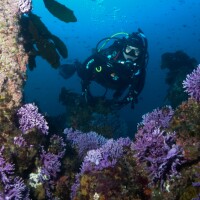Biosphere 2: The Back Story

From 1991 to 1993, marine researcher Gaie Alling and Mark “Laser” Van Thillo, a Belgian engineer, took part in an audacious scientific experiment in Arizona. Created by Space Biospheres Ventures, Biosphere 2 was a three-acre sealed environment initially built to demonstrate the viability of closed ecological systems to support and maintain human life, in remote earth locations like Antarctica and in outer space. It was also a laboratory for the study of global ecology where scientists could explore the web of interactions within life systems.
Comparable to the size of two and a half football fields, Biosphere 2’s interior was complete with rainforests, an ocean with waves and living coral reef, a mangrove wetland, savannah grasslands and fog desert, as well as an organic farm for food production to allow people to live self-sufficiently inside the structure for years at a time.
Funded by a wealthy Texas oilman, the $180 million project was the brainchild of John Allen, a systems ecologist and engineer. The team he brought together included scientists, visionaries, engineers, artists and technicians, who thought big about what it would take to better understand how the Earth’s biosphere functions. Discover Magazine called it “the most exciting scientific project to be undertaken in the United States since President Kennedy launched us toward the moon.”
I first visited Biosphere 2 while it was under construction, as a producer for ABC News PrimeTime Live. I was surprised to discover that Gaie Alling was one of the principal scientists: we had happened to meet five years earlier in Sri Lanka, where she was doing graduate research on whales. It was amazing to see the meticulous preparation for the scientific projects, and to watch as the crew hoisted in giant trees for the rainforest, and hundreds of corals from Mexico to create a reef in the million-gallon ocean, before sealing the structure with more than 3,000 glass panels.
In our first network report about Biosphere 2, Sam Donaldson interviewed Gaie the day after she and Laser were chosen to be part of the first team of eight humans to be sealed inside Biosphere 2 for two years.

The first Biosphere 2 mission began with a lot of fanfare on September 26, 1991. But a problem soon developed – high CO2 and low oxygen in the air. As the humans acclimated to living at the equivalent of high altitudes, they had to figure out what was going on and what to do about it. Eventually it was determined that the extra biomass that had been added to the soil for crops was generating extra CO2. Plus it turned out that the planners had not foreseen that exposed concrete in the base of the structure would absorb oxygen, which caused oxygen levels in the air to decline.
Meanwhile, problems with the corals that Gaie had brought into the ocean seemed to be an indicator of some of the problems the mini-biosphere was experiencing: it was the first time scientists began to address issues with ocean acidification. Marine expert Phil Dustan was brought in to consult via a videoconference link. Eventually the Biospherians were able to stabilize the atmosphere, and learned much from their struggles to balance the systems that make up life on our planet.
Biosphere 2 is now managed by the University of Arizona.

[See a comprehensive tour of Biosphere 2 made several years ago by an amateur photographer.]
What Gaie and Laser learned inspired them to create the Biosphere Foundation and establish a Planetary Coral Reef Expedition around the world to bring attention to the plight of the reefs. After leaving the Biosphere 2 organization in 1994, Gaie and Laser put together the funds to outfit the first of several sailing vessels they have used to study marine issues around the planet.
In 2004, as they sailed through the South Pacific, they heard about a beautiful coral reef in the Phoenix Islands. But when they got there the crew found only bleached and dead coral. Digging into NOAA temperature records, they noted an extended period of very warm sea water.
Their corals advisor in 1991, Phil Dustan, has been working with them for years and now makes annual trips to Bali. In addition to his role in making Earth Focus: Vanishing Coral, Phil was prominently interviewed in the powerful new feature documentary Chasing Coral, which will be coming to theatres and Netflix later in 2017.
Gaie and Laser continue to focus on global environmental issues through their Biosphere Foundation, now based on the sailing vessel Mir. Over the years, several of the original Biosphere 2 team have worked alongside them, including Sally “Sierra” Silverstone, who had been the Director of Agriculture and was responsible for feeding the team of eight for two years. Sierra now lives in Bali and runs the Foundation’s education programs.
Sierra, Gaie and Laser’s story is told in the documentary “Odyssey in Two Biospheres,” available on Link TV.


